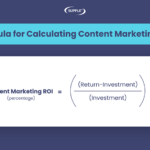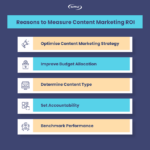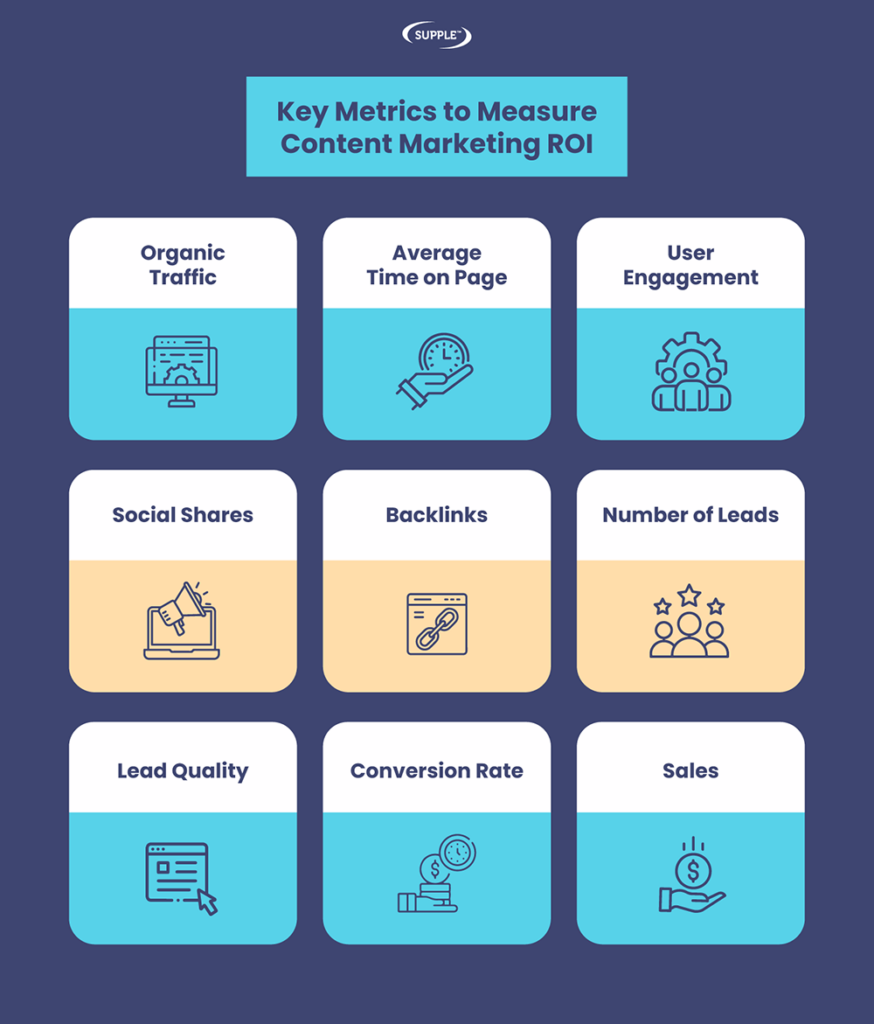Content marketing ROI: How to Define and Measure it?
Content marketing is one of the most crucial parts of a marketing strategy. But given the growing competition in the market, it can be extremely challenging to measure the effectiveness of your content marketing efforts.
This is exactly why learning how to measure content marketing ROI is so important. By calculating the actual ROI of your content marketing, you can figure out how much revenue you’re generating compared to the amount you invest in producing as well as distributing your content.
If you’re struggling to measure the success of your content marketing campaigns, you’re not alone. Many businesses actually struggle to define and measure their content marketing ROI.
Fortunately, measuring content marketing ROI is not rocket science. By using the right tools and strategies, not only can you measure the exact ROI of your content marketing efforts but can also identify areas to improve.
In this article, we will explore the content marketing ROI in detail, covering the calculation formula and the reasons to measure it.
Afterwards, we will discuss the nine key metrics you need to track for measuring your content marketing ROI.
What is Content Marketing ROI?
Content marketing ROI (Return on Investment) is a measurement of how much revenue a company generates from its content marketing efforts compared to what it spent.
Content marketing ROI is an important metric to track and measure because it helps businesses identify how their content marketing strategy has performed.
This, in turn, can not only aid future content marketing decisions but also helps businesses optimise their content marketing strategy for maximum profitability.
How to Calculate Content Marketing ROI?
To calculate the content marketing ROI, first, you need to find out the total cost of your content marketing campaign. This may include expenses such as content creation, distribution, and promotion costs.
Once you have the total cost figure, you need to measure the impact your content marketing campaign had on your business’s overall revenue or cost savings.
Here is the mathematical formula to calculate your content marketing ROI:

By calculating the ROI of your content marketing campaign using the above formula, you can determine if your strategy is generating a positive ROI.
In other words, if your content marketing efforts are bringing in more money than it costs.
Reasons to Measure Your Content Marketing ROI
Now you have learned what is content marketing ROI and how to calculate it, let’s discuss some key reasons why every business should measure it.

Optimise Content Marketing Strategy
Measuring the ROI of content marketing allows businesses to identify which efforts are driving the most revenue and which are not. From this data, businesses can optimise their content marketing strategy accordingly to generate the maximum ROI possible.
For example, after measuring the content marketing ROI a business may find that text content is more effective compared to visual content. Based on this insight, businesses can upgrade their content marketing strategy accordingly.
Improve Budget Allocation
In addition to figuring out which content marketing efforts are driving the most revenue, it is equally important to find out the total amount spent on your marketing efforts. By doing so, businesses can better allocate their budget more effectively.
For example, if a business finds out that social media marketing is generating better ROI compared to email marketing, it can reallocate some of the capital from the email marketing budget to their social media marketing campaigns.
This way, they can increase their overall revenue while spending the same amount of capital on their content marketing efforts.
Determine Content Type
Another benefit of calculating content marketing ROI is that it helps to find out which content types are resonating best with the target audience.
Based on this data, businesses can focus on creating content formats, topics, and distribution channels that are driving the highest revenue.
This, in turn, can help businesses in creating higher-quality content that engages and converts more visitors into paying customers.
Set Accountability
When businesses calculate content marketing ROI with a clear objective, it helps them to stay on track and be accountable for the performance of their overall strategy.
To elaborate, it allows businesses to identify areas that need attention and improvement and make the necessary adjustments to their content marketing strategy. And this kind of accountability helps them to keep their marketing team focused and motivated.
Benchmark Performance
Last but not least, measuring content marketing ROI helps businesses to find out how well their strategy is performing compared to their competitors and industry standards.
This helps businesses to know if their content marketing efforts are producing good results or if they need to make any specific improvements to their strategy for driving better results.
By comparing their performance with others in the same industry, businesses can revamp their content marketing strategy and stay ahead of the competition.
9 Key Metrics to Measure Content Marketing ROI
This is the most challenging part — identifying the right metrics to calculate ROI of content marketing accurately.
Fortunately for you, we’ve already compiled a list of key metrics to track for measuring the ROI of your content marketing efforts.

1. Organic Traffic
Organic traffic is an essential metric to measure because it indicates how well your content is ranking on search engines. For the uninitiated, it refers to the number of visitors that arrive on your website through search engine results.
By tracking your organic website traffic, you can gain valuable insights into how effective your content marketing efforts are at driving new visitors to your website.
Let’s suppose you’re a plumbing business in Sydney that is actively investing in content marketing to increase organic traffic to your website. By tracking this metric, you can discover if your content marketing efforts are generating any fruitful results.
Not only that but once you start tracking how much organic traffic your content marketing campaign is driving to your website, you can compare the total cost of content creation & promotion against overall sales and revenue generated from the content.
From these insights, you can find out whether your investment in content marketing is yielding a positive ROI or not.To track your organic traffic, you need to integrate Google Analytics into your website. It is a free tool by Google that allows website owners to track their organic traffic.
2. Average Time on Page
The average time on page is the average amount of time that visitors spend reading content on your website.
Tracking this metric is crucial because it helps to assess your content quality. For instance, if visitors spend a long time on your pages, it indicates that your content is engaging and provides value to your audience.
On the other hand, a low average time on the page may indicate that your content needs improvement.
By tracking the average time visitors spend on your website, you can gain insights into which blog posts or pages are most engaging to your target audience and where visitors are losing interest.
This can help to identify roadblocks and potential opportunities to improve your content and increase engagement, which brings us to the next metric.
3. User Engagement
User engagement is about tracking the level of interaction that users have with your content. This includes actions like commenting, liking, sharing, clicking on a link or button, or filling out a form.
Tracking user engagement is essential because it indicates how well your content engages your target audience. A high user engagement rate means that your content is appealing to the visitors and they are taking encouraged actions.
By comparing the amount of engagement your content generates to the amount of time and resources you invest in creating and promoting your content, you can determine whether your content marketing efforts are generating your desired results.
4. Social Shares
Social shares are an act of sharing content such as articles, blog posts, case studies, images, or videos on social media platforms like Facebook, Twitter, LinkedIn, and others.
When your content is shared on social media, it can reach a wider audience and generate more traffic to your website, which can ultimately lead to more leads, sales, and revenue.
Moreover, social shares can also help build brand awareness and trust, which can lead to long-term benefits such as customer loyalty and repeat business.
By tracking social shares, you can gain insights into the impact your content is having on your brand’s reputation and track how it is perceived by your target audience.
5. Backlinks
Tracking the number of backlinks acquired from your content marketing efforts can be quite helpful in measuring its ROI.
Backlinks, as you may already know, are one of the most important ranking factors. When you execute a link-building campaign and other websites start linking to your content, it can drastically increase your website’s visibility in search results, which can ultimately lead to more organic traffic and even sales.
So, by tracking the number of backlinks acquired, you can assess how your content is received by other websites in your industry.
Furthermore, tracking this metric also helps in gaining insights into the impact your content marketing efforts are having on your website’s reputation.
6. Number of Leads
The number of leads metrics of one of the most critical metrics that every business must be tracking for calculating their content marketing ROI.
For the uninitiated, leads are basically the number of people who have expressed interest in your products or services by providing their contact information.
Tracking this particular metric is crucial because it indicates the effectiveness of your content in generating leads. If your content is attracting leads, it means that it’s providing value to your audience and is helping to move them further down the sales funnel.
On the other hand, if your content is not generating as many leads as it should, it is a clear indication that your content marketing strategy is underperforming and needs to be improved immediately.
3. Lead Quality
Along with the number of leads, businesses must also track the quality of every lead that they generate through their content marketing efforts.
Lead quality helps to determine the level of interest and engagement that leads have with your brand. It helps to gauge the potential for these leads to convert into customers.
High-quality leads are those who are more likely to make a purchase and become loyal customers. By measuring lead quality, you can determine if your content is attracting the right audience.
You can measure the quality of your leads by analysing the demographics, behaviour, and actions of your leads. This information can help you determine if your content is resonating with your target audience.
8. Conversion Rate
Conversion rate is another important metric you can consider tracking to measure your content marketing ROI.
For the uninitiated, the conversion rate is the percentage of website visitors who take a desired action, such as filling out a form or making a purchase.
Whether you have hosted your website on WordPress or Wix or any other platform, you can easily track the conversion rates. Furthermore, you can even find out if your content is optimised for leading visitors into taking desired actions such as completing a purchase or filling out a form from Google Analytics 4.
And once you know the cost of creating and promoting your content, you can calculate the ROI by comparing the revenue generated from conversions to the cost of creating the content.
Doing so will help you measure the return on your investment and determine whether your content marketing efforts are bringing in more money than it costs.
9. Sales
Ultimately, the goal of content marketing is to drive and grow sales. That’s why it is essential to track the number of sales generated from your content marketing efforts.
By tracking the source of each sale, you can identify how many sales were directly generated by your content marketing efforts.
Once you have this data, you can calculate the ROI of content marketing by comparing the revenue generated from sales to the cost of creating and promoting your content.
This will give you a clear understanding of the return on your investment and help you determine the effectiveness of your content marketing efforts.
Start Measuring your Content Marketing ROI
Content marketing can be a powerful tool for driving business growth and increasing ROI.
However, to truly reap the benefits of content marketing, it’s important to define your goals and metrics for success, and consistently measure and analyse your results.
By focusing on these key metrics, you can gain valuable insights into the effectiveness of your content marketing efforts. And by continuously optimising your content marketing strategy, you can achieve a successful and sustainable content marketing ROI.
FAQs
What is the ROI of content strategy?
The ROI of a content strategy refers to the return on investment that a company receives from its content marketing efforts.
How to calculate ROI of a content marketing campaign?
To calculate the ROI of a content marketing campaign, you need to compare the cost of creating and promoting the content with the revenue generated by it.
How much time does it take for content marketing to show ROI?
Content marketing is a long-term strategy, which is why the time it takes to show ROI varies depending on several factors, such as the industry, the target audience, and the marketing budget.
What can be considered a good conversion rate for content marketing?
On average, a good conversion rate for content marketing ranges from 2% to 5%.
What are the main four steps to measure content marketing ROI?
The four steps involved in measuring content marketing ROI are setting goals & KPIs, tracking & measuring metrics, calculating the cost of content marketing, and calculating the ROI using the standard formula.
DIGITAL MARKETING FOR ALL OF AUSTRALIA
- SEO AgencyMelbourne
- SEO AgencySydney
- SEO AgencyBrisbane
- SEO AgencyAdelaide
- SEO AgencyPerth
- SEO AgencyCanberra
- SEO AgencyHobart
- SEO AgencyDarwin
- SEO AgencyGold Coast
- We work with all businesses across Australia




